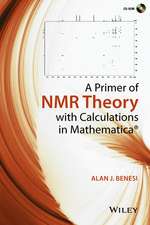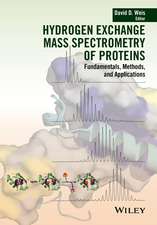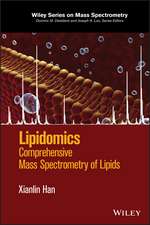Solid State NMR Spectroscopy for Biopolymers: Principles and Applications
Autor Hazime Saitô, Isao Ando, Akira Naitoen Limba Engleză Paperback – 25 noi 2010
| Toate formatele și edițiile | Preț | Express |
|---|---|---|
| Paperback (1) | 953.20 lei 6-8 săpt. | |
| SPRINGER NETHERLANDS – 25 noi 2010 | 953.20 lei 6-8 săpt. | |
| Hardback (1) | 960.93 lei 6-8 săpt. | |
| SPRINGER NETHERLANDS – 5 iul 2006 | 960.93 lei 6-8 săpt. |
Preț: 953.20 lei
Preț vechi: 1162.43 lei
-18% Nou
Puncte Express: 1430
Preț estimativ în valută:
182.42€ • 190.20$ • 151.60£
182.42€ • 190.20$ • 151.60£
Carte tipărită la comandă
Livrare economică 21 martie-04 aprilie
Preluare comenzi: 021 569.72.76
Specificații
ISBN-13: 9789048171002
ISBN-10: 9048171008
Pagini: 480
Ilustrații: XIII, 455 p.
Dimensiuni: 160 x 240 x 25 mm
Greutate: 0.67 kg
Ediția:Softcover reprint of hardcover 1st ed. 2006
Editura: SPRINGER NETHERLANDS
Colecția Springer
Locul publicării:Dordrecht, Netherlands
ISBN-10: 9048171008
Pagini: 480
Ilustrații: XIII, 455 p.
Dimensiuni: 160 x 240 x 25 mm
Greutate: 0.67 kg
Ediția:Softcover reprint of hardcover 1st ed. 2006
Editura: SPRINGER NETHERLANDS
Colecția Springer
Locul publicării:Dordrecht, Netherlands
Public țintă
ResearchCuprins
Part I: Principles:
Solid state NMR approach: CP-MAS and DD-MAS NMR.- Quadrupolar nuclei.- Brief outline of NMR parameters: Chemical shifts.- Relaxation parameters.- Dynamics-dependent suppression of peaks.- Multinuclear approaches: 31P NMR.- 2H NMR.- 17O NMR.- Experimental strategies: Isotope enrichment (labeling).- Assignment of peaks.- Ultra high-field and ultra high-speed MAS NMR spectroscopy.- NMR constraints for structural determination: Orientational constraint.- Interatomic distance.- Torsion angles.- Conformation-dependent 13C chemical shifts.- Dynamics: Fast motions with motional frequency >106 Hz.- Intermediate or slow motions with frequency between 106 and 103 Hz.- Very slow motions with frequency < 103 Hz.
Part II: Applications:
Hydrogen bonded systems: Hydrogen bond shifts.- 2H quadrupolar coupling constant.- Fibrous proteins: Collagen fibrils.- Elastin.- Cerial proteins.- Silk fibroin.- Keratin.- Bacteriophage coat protein.- Polysaccharides: Distinction of polymorphs.- Network structure, dynamics and gelation mechanism.- Polypeptides as new materials: Liquid crystalline polypeptides.- Blend system.- Globular proteins: (Almost) complete assignment of 13C NMR spectra of globular proteins.- 3D structure: alpha-spectrin SH3 domain.- Ligand-binding to globular protein.- Membrane protein I: dynamic picture: Bacteriorhodopsin.- Phoborhodopsin and its cognitive transducer.- Diacylgycerol kinase.- Membrane proteins II: 3D structure: 3D structure of mechanically aligned membrane proteins.- Secondary structure based on distance constraints.- Biologically active membrane-associated peptides: Channel-forming peptides.- Antimicrobial peptides.- Opioid peptides.- Fusion peptides.- Membrane model system.- Amyloid and related biomolecules: Amyloid beta-peptide.- Calcitonin (CT).
Recenzii
From the reviews:
"This book surveys much of the current research in the area of biological solid-state NMR spectroscopy, and as such should be of great interest to the chemical, biochemical, and biophysical communities. The level is appropriate for graduate students, and the book would be an excellent textbook for a graduate level course in biological solid-state NMR spectroscopy. Its publication is timely considering the recent numerous developments in this area … ." (Michele Auger, Journal of the American Chemical Society, Vol. 129 (10), 2007)
"This book surveys much of the current research in the area of biological solid-state NMR spectroscopy, and as such should be of great interest to the chemical, biochemical, and biophysical communities. The level is appropriate for graduate students, and the book would be an excellent textbook for a graduate level course in biological solid-state NMR spectroscopy. Its publication is timely considering the recent numerous developments in this area … ." (Michele Auger, Journal of the American Chemical Society, Vol. 129 (10), 2007)
Textul de pe ultima copertă
Solid State NMR Spectroscopy for Biopolymers
Principles and Applications
by Hazime Saitô, Isao Ando and Akira Naito
Unique and comprehensive coverage of solid state NMR, emphasising
secondary structure and dynamics in relation to biological function.
When considering the biological significance and industrial and medical applications of biopolymers, it is crucial to know details of their secondary structure, dynamics and assembly. The biopolymers include globular, membrane and fibrous proteins, polypeptides, nucleic acids, polysaccharides and lipids. Solid state NMR spectroscopy has proved to be the most suitable and unrivaled means for investigations of biopolymers. The major advantage of solid state NMR spectroscopy is that the resulting line widths can be manipulated experimentally and are not influenced by motional fluctuation of proteins under consideration as a whole.
Solid State NMR Spectroscopy for Biopolymers: Principles and Applications provides a comprehensive account on how the conformation and dynamics of such biopolymers can be revealed by solid state NMR spectroscopy. Special efforts have been made towards the historical and chronological consequences of a variety of applications and the dynamic aspects of the biopolymer system. In particular, the authors emphasise how important it is to record the most simple DD-MAS (one pulse excitation with high power decoupling) as a mean of locating very flexible portions of membrane proteins and membrane associated peptides. The authors also demonstrate that dynamic features of membrane proteins with a timescale of fast (108 Hz) and intermediate (104 -105 Hz) fluctuation motions can be revealed easily by specific suppression of peaks.
This book is an invaluable resource for biophysicists, biochemists and chemists, including NMR spectroscopists, structural biologists, and polymerscientists. The book provides an introduction suitable for graduate students as well as for research scientists, including those working in the pharmaceutical and chemical industries.
Principles and Applications
by Hazime Saitô, Isao Ando and Akira Naito
Unique and comprehensive coverage of solid state NMR, emphasising
secondary structure and dynamics in relation to biological function.
When considering the biological significance and industrial and medical applications of biopolymers, it is crucial to know details of their secondary structure, dynamics and assembly. The biopolymers include globular, membrane and fibrous proteins, polypeptides, nucleic acids, polysaccharides and lipids. Solid state NMR spectroscopy has proved to be the most suitable and unrivaled means for investigations of biopolymers. The major advantage of solid state NMR spectroscopy is that the resulting line widths can be manipulated experimentally and are not influenced by motional fluctuation of proteins under consideration as a whole.
Solid State NMR Spectroscopy for Biopolymers: Principles and Applications provides a comprehensive account on how the conformation and dynamics of such biopolymers can be revealed by solid state NMR spectroscopy. Special efforts have been made towards the historical and chronological consequences of a variety of applications and the dynamic aspects of the biopolymer system. In particular, the authors emphasise how important it is to record the most simple DD-MAS (one pulse excitation with high power decoupling) as a mean of locating very flexible portions of membrane proteins and membrane associated peptides. The authors also demonstrate that dynamic features of membrane proteins with a timescale of fast (108 Hz) and intermediate (104 -105 Hz) fluctuation motions can be revealed easily by specific suppression of peaks.
This book is an invaluable resource for biophysicists, biochemists and chemists, including NMR spectroscopists, structural biologists, and polymerscientists. The book provides an introduction suitable for graduate students as well as for research scientists, including those working in the pharmaceutical and chemical industries.
Caracteristici
Uniquely presents a comprehensive account of solid state NMR with an emphasis on revealing secondary structure and dynamics in relation to biological functions. Biopolymers-oriented, not just methodology-oriented. Not a compilation of recent progress on solid state NMR, as often attempted by other authors. Focuses on characterization, revealing secondary structure and dynamics as revealed by solid-state NMR. Emphasis on the chronological account of such studies.







